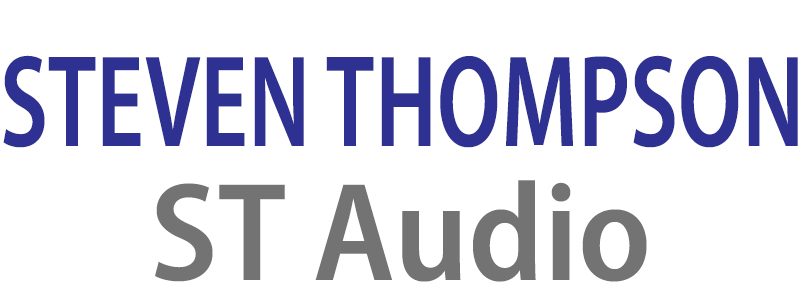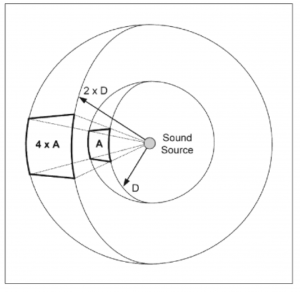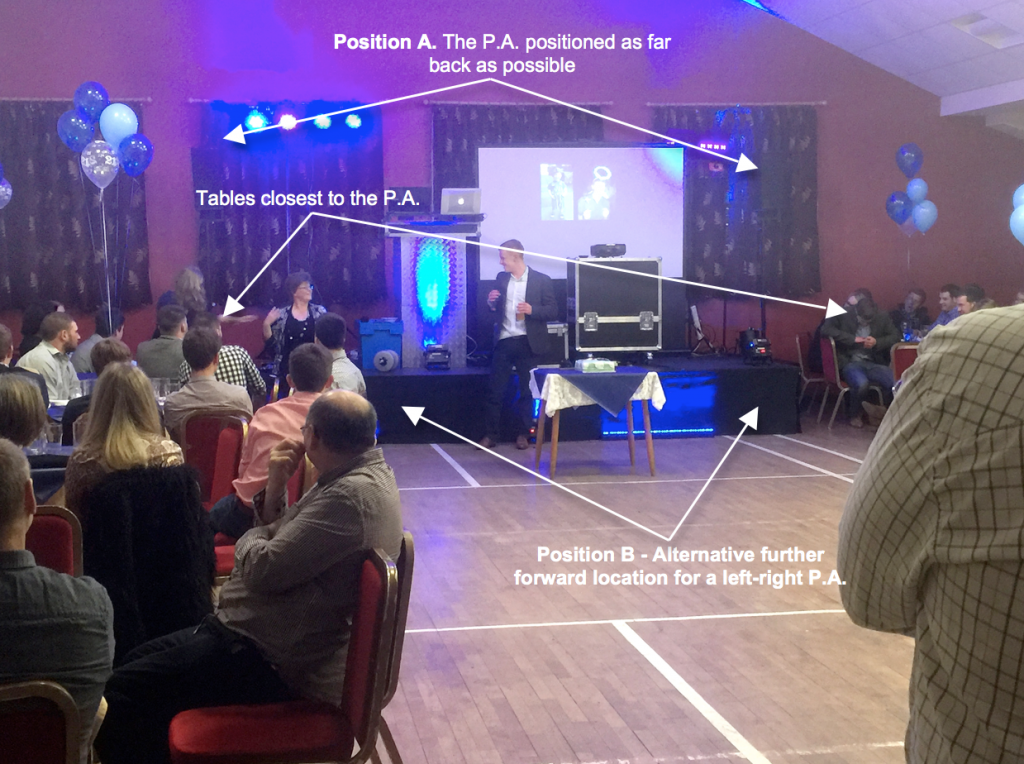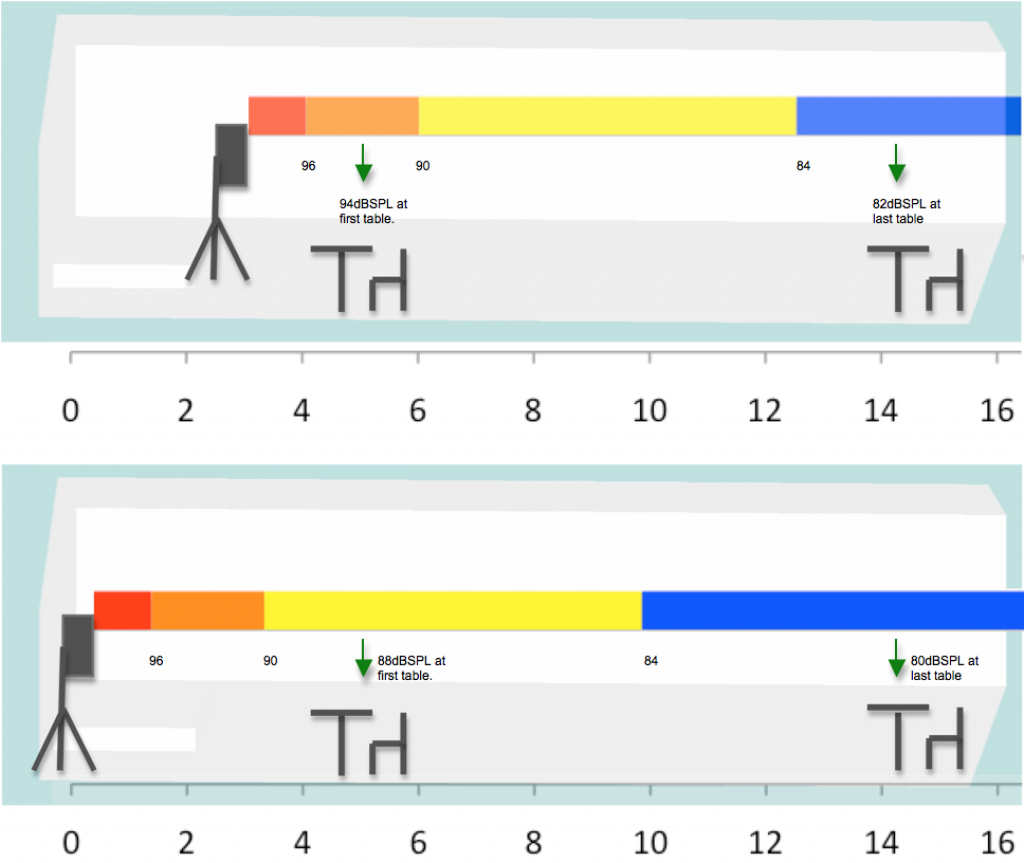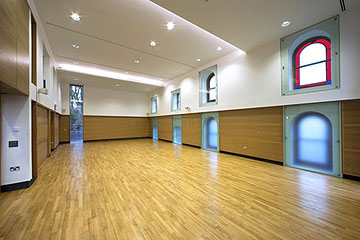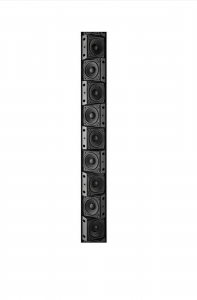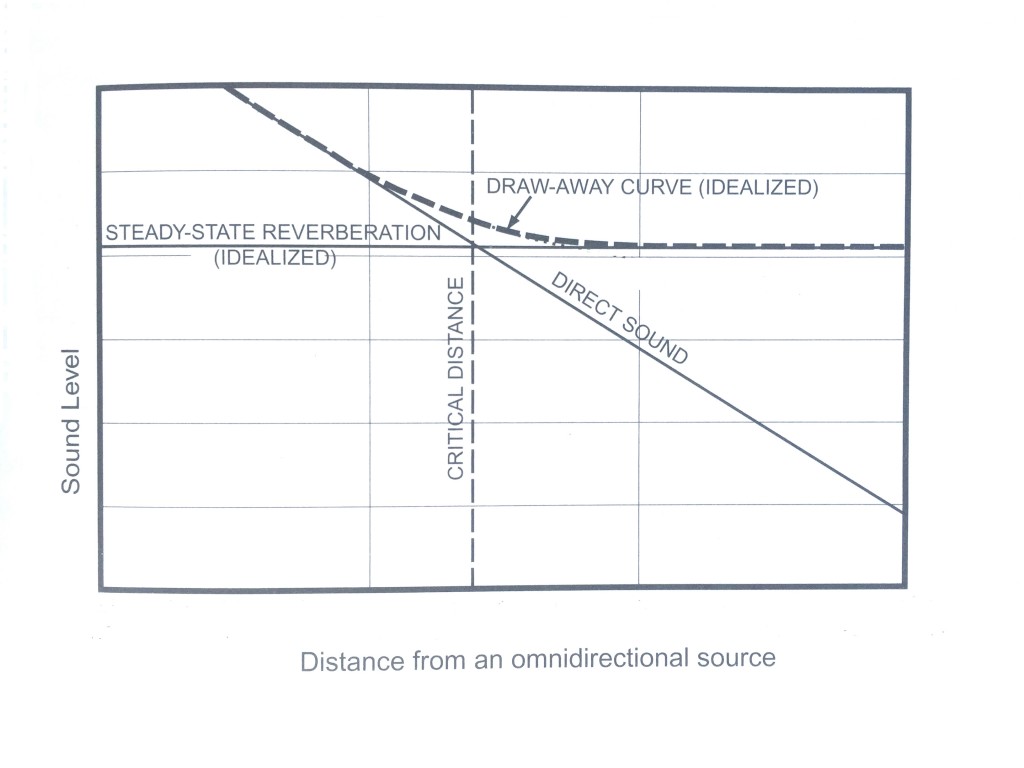Sound Pressure Level And Distribution
You can jump to content in this section by using the links below, or, use the menu to the right to reach other sections within the guide.
1. Determining Appropriate Level
2. SPL By Law
3 How Does Power Rating And Sensitivity Come Into This?
4. How Important Is Level Variation?
5. Achieving Greater Control Over Level Distribution Throughout The Venue
5A. Move The Loudspeaker System Back From The First Listener And Higher In Elevation
5B. Reduce The Rate Of Drop Off In Level Over Distance By Using Drivers Which Couple
5B I. Dipole Loudspeaker
5B II. Line Array Of Drivers
5B III. Is It Worth Investing In This Type Of Technology?
5C. Introduce A Secondary System, Part Of The Way Down The Length Of A Venue
6 Should There Be The Same Level Throughout The Venue Though?
Determining Appropriate Level
Target SPL should be considered on an event / programme type basis. Some publications offer guidelines, for example that a ‘typical disco’ may be between 90 and 120 dBSPL (Stark, 2004). Such approximate figures are however rather limited in practical application, so let’s try a more pragmatic approach.
As the performers, we often use our judgement to determine appropriate level by nature of what we’re trying to achieve at a given point in an event, or perhaps based on the relevant aspects of our audience’s demographic. In a mobile DJ, vocalist or band context, typically we’d consider where a gig is up to in terms of for instance;
- Are people eating and talking, so is our role therefore providing background or atmosphere?
- Are we about speak, or hand a microphone over to the client for a presentation?
- Are we at a stage where need to excite the dance floor and get more bodies up?
There’s a lot of scope to the common sense approach in setting an appropriate level…
With recorded music running through the P.A., it’s almost always worthwhile moving to a tabled or seated part of a venue and considering the basic question: would I be comfortable having a conversation if I was here? Or if getting the dance floor busy is the objective, then perhaps actually getting out on the floor and asking ‘am I pleasantly immersed with a good sound level which might excite me to dance?’. After all, it’s questions of this nature which the majority of our audience, were they to be concerned over sound level, would subconsciously be thinking.
We should also consider headroom. In short, this describes the difference between the average working levels and the peak. It’s a good idea to establish the greatest level at which we’ll need to work for a given event, in order to achieve our performance goals (and based on the needs of our audience), and then operate a number of dB less for the average of the time. Bands typically set peak level against their loudest instrument, which is usually the drums acoustically speaking.
If we play a more background role earlier on, it might be useful to consider that -10dBSPL is typically perceived as a halving of loudness. Taking mental note of our peak required level is important, either by reference level on the console / mixer or amplifier, or on an SPL meter. Even an SPL meter available on your smart phone, (such as Decibel Ultra), will improve loudness judgement.
You may already be setting your peak level before guest arrival, and actively getting out in front of the P.A. to check it. If you’re doing this by default, good, keep doing it! The points in this paragraph may seem to labour on the common sense, but the reality is, common sense lays the foundation for professional P.A. We might not have the time later during performance to get out in front of the P.A. and make adjustments. Of course having bodies in a room will cause some aspects of your sound to differ once guests arrive, but it’s still highly valuable to have had an audience-ears-view of your system at its peak level, in a particular space before you begin.
SPL By Law
A professional approach to the setting of level should also conform to statutory requirements. There are two areas of consideration here. One being that sound perceived as too loud within property neighbouring the venue can be deemed as nuisance under the Environmental Protection Act (1990). Noise complaints are investigated by council officers and / or law enforcement and warnings, abatements, fix penalty notices and confiscations can follow. Permitted noise levels would be checked on an A-Weighted dBSPL meter, within a neighbouring property to ensure they do not exceed ‘34 dBA if the underlying level of noise is no more than 24 dBA and 10 dBA above the underlying level of noise if this is more than 24 dBA’ (Crown Copyright, 2015)
The Health and Safety Executive is a second area of statutory consideration. The Control Of Noise At Work Regulations 2005 specify an exposure limit of 87dBLAeq, (a dB reference used to calculate ‘daily or weekly average exposure’ levels (H.S.E, n.d.). Even though these regulations don’t apply to patrons, if a venue is found in contravention through one of its members of staff, the business can receive a large fine. From both this and the nuisance stand point, venue management often have a vested interested in minimising SPL; and we may have a vested interest in meeting the venue management’s objectives.
The important question is then, what can we do to achieve economy in SPL; enough to meet our performance goals without raising the risk of problems with others? Time to consider some key phenomena from;
- The study of human’s perception of sound – psychoacoustics,
- And the study of how sound propagating from our loudspeakers interacts within the venue’s environment.
The ear-brain system’s sensitivity is not the same across all frequencies. Here’s an example of how we can use this knowledge: The broadband SPL figure deemed appropriate for speech at an event could be a smaller number, if the frequency content at the point of reception at a listener’s ear;
- Is high pass filtered up until around 120Hz; (get rid of the low end which does not contribute to the clarity of speech).
- Has good body around 600Hz,
- Is well defined between around 2 and 4.5kHz.
Even better if our system design (that includes both the manufacturer’s design and our own set up choices), reduces the acoustic power reaching the walls and ceiling of a venue. The intention is to focus direct sound on listening positions, reducing reverberation, which will also affectively lower the noise floor of the venue. We can then operate at even lower levels while achieving the same clarity.
There’s perhaps an irony here, that a P.A. system which achieves an increased amount of direct sound on an audience, may result in a situation towards the back of a reverberant hall which is perceived as less noisy.
In A Nutshell
- We should pay continued attention to our level as it evolves through the progress of an event.
- Being perceived as too loud can have majorly detrimental effects to our performance.
-
By optimising the frequency response and dispersion of our sound systems to compliment the venue and the event type, it is possible to operate at a reduced broadband SPL. The result is safer both in terms of everyone’s hearing and in avoiding the risk of noise complaints. Yet, we can still deliver intelligible sound with sufficient dance floor excitement. More on EQing P.A. systems with venue acoustics in mind can be found here.
How Does Power Rating And Sensitivity Come Into This?
This guide will not dedicate much of its concern to power. It is more interested in the control of available power and directing it to the appropriate places.
Figures offered between various manufactures regarding power are typically not compatible. Results can be very different depending upon what type of test signal is used. Wattage figures cannot be relied upon to inform us of what the greatest level a loudspeaker can achieve, is; not even at 1 meter. There are too many other pieces of information which we’d also need along with amplification wattage figures, including power handling and the behaviour of the system’s limiting; (which involves both long and short term dynamics management).
In A Nutshell
Wattage comparisons between systems are neither reliable nor a worthwhile indication of the SPL which a loudspeaker can achieve.
The dBSPL achieved at 1 meter on-axis when a loudspeaker system is driven with 1 watt of power, is a common method used by manufacturers to specify power. This is referred to as sensitivity, but is limited in application. It cannot be used as a measurement of efficiency, due to not being representative of the loudspeaker off-axis. Neither does it tell us how loud the system will be at a given listening position, once the summation of multiple loudspeakers, distance from the system and room acoustics are thrown into the equation.
An alternative sensitivity measure. Click to read more.
McCarthy (2008), puts forward a revised sensitivity specification measured upon how many dBSPL are achieved at any given point in a room, when the loudspeaker system is driven by 1Volt. This takes into account key electroacoustic characteristics that 1watt at 1 meter does not. However, it isn’t a figure which manufacturers could use in their technical specifications.
What we need is a method of predicting before a gig, whether we will be able to achieve sufficient SPL across a venue. Or do we?…
…Based collectively on the experiences informing this guide and the measurements taken ahead of writing, the reality is that in many indoor venues with a capacity up to 250 people and for a number of sound entertainment performance types, a modern pair of actively amplified (self powering) point source loudspeakers with;
-A 12 inch low frequency (direct radiating) driver and a horn loaded compression driver,
– And with starting price of £350 a side,
– From a manufacturer with mass market commercial success,
Could be deemed sufficient in terms of power to create great enough SPL. The efficiency at which the system operates, its reliability over time and its ability to distribute SPL to where it’s needed, then become the more critical factors.
How Important Is Level Variation?
There is more to the question of appropriate level however. Do we need our level to be the same across all guest locations in a venue? If we were to read a publication geared towards sound for a paid ticket show (such as in theatre or a concert), then achieving minimal variation in SPL would be one of our priorities. In our context though, perhaps the answer varies depending on the performer’s goals. We’ll therefore refer to this next section as increasing our ability to manage (control) SPL across a venue, as oppose to simply reducing variation.
Methods For Achieving Greater Control Over Level Distribution Throughout The Venue
- Moving the loudspeaker system back from the first listener and higher in elevation.
- Reducing the rate of drop off over distance by using drivers which couple on axis.
- Introducing a secondary system, known as a delay – fill, part of the way down the length of a venue.
Move The Loudspeaker System Back From The First Listener And Higher In Elevation
Consider a fixed amount sound output from a loudspeaker. As distance increases away from the loudspeaker, the propagation of that energy is spread over an increasing greater surface area. Consequently the pressure reduces over distance. Figure 1 describes the Inverse square Law. This is the rate at which SPL reduces over distance from an omni directional, infinitely small point (in a reflection free zone). The term point source is used to describe this type of sound propagation.
Figure 1
(Inverse Square Law For Sound Propagation, Boyce, 2014)
As the spaces we work in aren’t reflection free zones, (and for other reasons), this model only provides us with an estimate. The specific number of dB by which a point source loudspeaker system reduces per doubling of distance, will vary slightly on a venue-by-venue basis. This is dependant on the directional characteristics of the speaker and to what extent it excites each venue. However it’s likely to be close to -6dB, which would mean that if your loudspeaker measured 96dBSPL at 1m, keeping test signal the same, it would measure close to 90dBSPL at 3m and 84dBSPL at 7m.
As you can see therefore, the quickest -6dB drop offs occur quite quickly, (over a short distance from the loudspeaker). In researching for this guide, the SPL reduction over distance for a range of systems were measured in locations frequently worked in by performers who supply their own P.A. For a commonly used, active point source cabinet (it was actually a Mackie SRM450v3), the first 6dB reduction point moving away from the loudspeaker, (using 1m away as a starting point) was on average 2.5m for 5 venues in which we carried out tests.
Figure 3 shows how by moving a loudspeaker just 2.5m further away from the audience, the table closet the the P.A. received 6dBSPL less. Firstly, Figure 2 shows a photo of the venue for context, and some notes on where the P.A. was located at a recent function in that same venue.
Figure 2
It’s worth nothing that in order to locate the left-right point source system in Position A, negotiation with the client had to take please in order to move the nearest tables further away from the stage. It is for that reason that on other occasions, the point source pair has needed to be located at Position B.
Figure 3
Position B – A point source pair is located in front of the stage. A measurement of each time the SPL reduced by 6 dBSPL moving back from the loudspeaker was made in the hall. There is 12dB difference between the first table and the last table. However, if the loudspeaker is moved back as far as possible (2.5m in this case), the SPL for the first table is more comfortable, as shown below by position A.
Position A – The point source pair was then moved back 2.5m, level with the back wall and to the sides of the stage. The level is now 6dB less at the first table, so we’re allowing them to converse. There’s also less front to back difference in the venue now; there’s 8dB difference between the first and last table, and this room was only 16m long. The advantage brought about by moving the loudspeakers back would be further emphasised in a longer room.
Reduce The Rate Of Drop Off In Level Over Distance By Using Drivers Which Couple
So some loudspeaker are capable of transmitting sound over longer distances, with less SPL drop off (attenuation). This can be achieved by having an alignment of drivers which cause addition of waveforms in front of the loudspeaker system. This is known as electroacoustic coupling.
If you were reading this guide hoping just for some basic recommendations, then knowing that some loudspeaker types are definitely (not just that manufactures say they are), capable of effectively throwing sound over greater distances, then this may be all you need to know. In that case, feel free to jump ahead to here. If however want to know more about how loudspeakers, both point and line source, increase concentration of acoustic energy on-axis (i.e. in front), take a look at this…
…There are numerous loudspeaker designs which result in multiple drivers affectively working together (coupling), for concentration of acoustic energy in front of the system (on-axis). Let’s look at two methods which might be appropriate for our area of the sound entertainment industry;
- A dipole arrangement of drivers in a point source cabinet.
- A line array of drivers in a column system.
This video explains how by setting drivers a specific distance apart, acoustic energy (and therefore SPL) is concentrated on-axis.
Dipole Loudspeaker
The video above explains how a dipole loudspeaker, so called due to the arrangement of drivers within it, concentrates SPL on-axis due to an electroacoustic event known as coupling. To put the benefit of coupling into context, while researching for this guide measurements were taken within a number of venues, and with a range of loudspeakers. Some of these systems where designed by the manufactures such that the drivers inside them work together to increase SPL on-axis, yet cancel each other out to some degree off-axis.
From those results, Figure 5 shows how a popular point source loudspeaker performs in a venue, in terms of level over distance. This loudspeaker, (a Mackie SRM450v3) has a single 15inch low frequency (LF) driver, which then crosses over to a 1.5inch high frequency (HF) driver. These two components mostly deal with separate areas of the frequency spectrum.
Figure 5 then goes on to compare this conventional point source loudspeaker’s performance, with a considerably more expensive system, (a d&b Audiotechnik Y7P) which takes advantage of drivers, which in front of the system, affectively work together as one larger driver over a certain frequency band.
First up though to set the scene, Figure 4 shows a photo of the venue which these measurements were taken in.
Figure 4. Slaidburn Village Hall – A Popular Venue For Wedding And Birthday Parties
Figure 5
A cut away diagram of the venue in the photo above. A comparison was made of the level variation on-axis over distance, between a loudspeaker who’s drivers are uncoupled and a loudspeaker who’s arrangement of drivers take some advantage from working together on-axis. Both loudspeakers were fed the same test signal. With the Mackie SRM450v3, SPL reduced at an average rate of 5dB per doubling of distance, and there was a 9dBSPL difference measured between the first and last listening positions.
The loudspeaker below takes advantage of driver coupling on-axis. As such, it could be described as a more highly engineered system, with a greater degree of technical consideration. This system has a greater concentration of acoustic power on-axis. This loudspeaker measured just 5dBSPL between the first and the last listening positions.
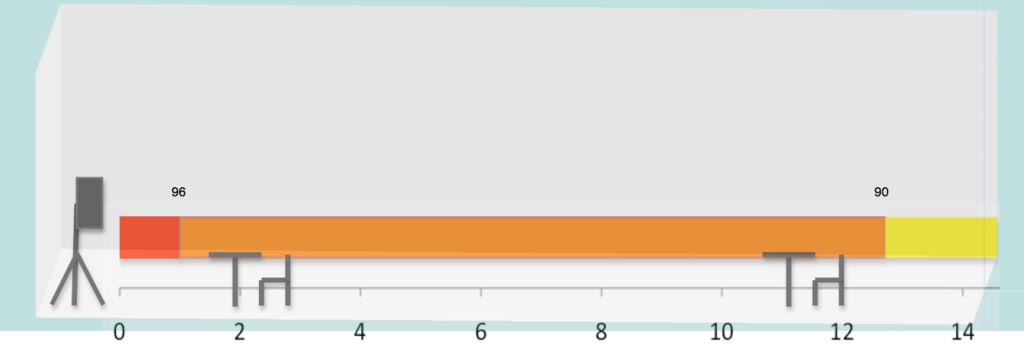
Line Array Of Drivers
Thankfully, the same physics concept of multiple drivers which work together for addition of SPL going forward, but cause cancellation (attenuation) above and below, applies for drivers that are arrayed in a long line within a column type loudspeaker.
Figure 6 shows one such loudspeaker system; the Bose L1 Model II, which has 24 small drivers, positioned on top of each other.
Figure 6. Drivers Arrayed In A Line Within A Column Loudspeaker
Is It Worth Investing In A Highly Engineered System?
So if you haven’t already, how important is it to take advantage of loudspeaker technology which is designed to concentrate acoustic power on-axis? As ever, so much depends on the venue and application. It’s worthwhile knowing that this technology exists and if you really did want to have more control over SPL at various locations in a venue, then your best efforts would be greatly helped by taking advantage of either a dipole or line arrayed design. For context, in both the halls shown in Figures 2 and 4 above, the conclusion was that the cheapest to purchase of the systems tested, (the Mackie SRM450v3, which represents a fairly typical and commonly used point source), was sufficient in both level and clarity at the back of the halls.
Take a listen here to a recorded comparison made of three systems at the back of one of these halls, and see what you think.
The two halls covered in the examples above had seated capacities of no more than 140. However, in a larger hall with more challenging reverberation characteristics, achieving intelligibility (clarity) became more critical.
Introduce A Secondary System, Part Of The Way Down The Length Of A Venue
A distributed system may be beyond the scope of the rigging or de-rigging time budget, (not to mention the fiscal or even space in the van budget!). During research ahead of writing, 48% of performer / P.A. operators said that they were either likely or very likely to work more than a single event during a day. I can think of many – a – Saturday where frankly, I feel a bit rushed to set up P.A. for an evening event after delivering a kids party elsewhere during the afternoon: and by that stage, simply getting P.A. in and on before guests arrive, is an achievement.
But you should know: Within the most reverberant of venues we work, the most intelligible and even level coverage results will most likely be achievable by setting up distributed system.
Wireless audio distribution devices can increase the scope of distributed system deployment, (also known as delay-fill loudspeakers). This guide intends to remain impartial towards specific manufactures and products. As places to start further research however, hardware from the likes of Alto with the Stealth at the budget end and Neutrick with Xirium in a higher price range may be worth a look.
Research ahead of writing noted that a number of performers who operate their own P.A. subscribe to the idea that guests don’t want the music to be particularly loud at the back, (as they want somewhere to converse throughout the event). This corroborates research conducted by this project with attendees at such events. Distributed systems therefore should not be considered for the purpose of making it loud at the back. Rather, a distributed system gives us the ability to improve speech intelligibility (clarity) at the back of the venue, without needing to make it too loud for the tables closet to the P.A. You might want to consider using an auxiliary on your mixer to send just the microphone signal to the loudspeakers further down the venue if you use a distributed set up.
At what distance to position secondary (also known as delay-fill) loudspeakers
In the big published books on P.A. design, there’s a theme for recognising when loudspeakers have reached their effective listener range. At that point (labelled critical distance in Figure 7), the general recommendation is to use a secondary pair of lowered powered loudspeakers, part way down the venue.
Figure 7. Critical Distance
The term DRAW-AWAY CURVE describes the theoretical cumulative sound level as a result of the direct and the reverberant sound fields.
(Adapted from: The Structure Of The Steady State Sound Field In An Idealised Large Performance Space, Toole, 2008)
An investigation conducted ahead of writing this piece, corroborates the recommendations made by published sound engineering authors. In a reverberant hall holding 250 seated (further details on that venue can be found here Venue Introduction & Measurements), a range of loudspeaker systems and placements were tested. The measurable and perceivably clearest and most even levelled results came from using distributed system, (in spite of us also testing a highly engineered system with a great deal of directional control, retailing at £10k +). You can listen to this case study here.
To summerise, we manage SPL better for guests / the audience by;
- Moving the loudspeaker system back from the first listener and higher in elevation.
- Reducing the rate of drop off over distance by improving directionality.
- Introduce a secondary system, known as a delay – fill, part of the way down the length of a venue.
Management Of SPL – Conclusion
This topic should definitely be addressed on an event type basis. We know that level drop off occurs naturally, and there are circumstances in mobile sound entertainment where it’s appropriate to embrace that. This would certainly lighten our workload in the case of not needing to put out a distributed system. Sometimes it’s advantageous to have a -10dB drop off front to back, so that guests who want to converse during the event can do so.
These methods above for greater control of SPL pertain more to preventing an uncomfortably loud environment for the closest listeners; yet maintain intelligibility at the furthest reaches of a venue.
